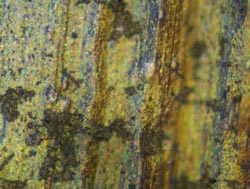Protecting drinking water systems from deliberate contamination

This is biofilm on a metal coupon which has been immersed in drinking water.<br><br>Credit: University of Southampton<br>
The importance of water and of water infrastructures to human health and to the running of our economy makes water systems likely targets for terrorism and CBRN (chemical, biological and radionuclide) contamination. Reducing the vulnerability of drinking water systems to deliberate attacks is one of the main security challenges.
SecurEau, a four-year Seventh Framework Programme funded project, involved 12 partners, including the University of Southampton, from six European countries. It has developed a toolbox that can be implemented by a major European city in response to a contamination event, which includes:
•tools for detecting water quality changes;
•methods for rapidly identifying the source(s) of intentional contamination;
•multi-step strategies for cleaning distribution systems;
•analytical methods for confirming cleaning procedure efficiency.
Research groups from the University of Southampton, the only UK partner in the project, developed new methods and technologies for detecting low levels of microbial and radiological contaminants and improving the efficiency of decontamination protocols, with special attention to the role of biofilms.
The SecurEau team developed water quality sensors to be installed in a drinking water system, which allows an alert to be issued rapidly when abrupt changes in the quality of water are detected. These were confirmed by development of specific molecular tools by Southampton and several other partners.
The team also developed 'sentinel coupons' of polymeric materials (HDPE, EDPME, etc.) to be installed in water distribution systems for deposits and biofilms to form on their inner surface. The coupons would be installed in the water supply system to monitor the concentration of the pollutant absorbed onto the like pipe walls. They would then be used to validate the cleaning procedures applied throughout the network during the crisis phase but also during 'normal' operation of the network.
Project partners also developed mathematical models to determine the areas which have been contaminated and the sources of contamination, and various cleaning methods, both traditional and new ones, to be applied to decontaminate the network.
Professor Bill Keevil, Director of Environmental Healthcare at the University of Southampton, says: “If a contamination event (accidental or deliberate) occurs in a drinking water network, it is essential to identify the sources of contamination and to determine the area which is likely to be contaminated, in order to isolate and decontaminate the affected area only, as well as keep supplying drinking water in non-affected areas.
“Our experiments show that coupon-monitoring devices are suited to follow deposit / biofilm formation in drinking water distribution systems as well as to investigate and confirm the successful removal of deposits from surfaces.”
Professor Ian Croudace, Director of the University's Geosciences Advisory Unit, adds: “Rapidly restoring the functionality of drinking water infrastructures (catchment areas, raw water transfer systems, treatment facilities, treated water reservoirs and distribution networks), and the access to safe drinking water represents another major concern for regulatory agencies and water utilities. Indeed, the damage resulting from impairment of drinking water services would seriously impact the quality of life of many people not only by directly harming them but also making water systems unusable for a long period of time with a risk of societal disorder (similar situation as with any accidental contamination events or natural disasters).”
This research has led to publication of a guide for end users and disseminated via a three day workshop in Germany involving 150 participants from 26 countries.
Further information is available from the project website http://www.secureau.eu
Media Contact
More Information:
http://www.soton.ac.ukAll latest news from the category: Ecology, The Environment and Conservation
This complex theme deals primarily with interactions between organisms and the environmental factors that impact them, but to a greater extent between individual inanimate environmental factors.
innovations-report offers informative reports and articles on topics such as climate protection, landscape conservation, ecological systems, wildlife and nature parks and ecosystem efficiency and balance.
Newest articles

Superradiant atoms could push the boundaries of how precisely time can be measured
Superradiant atoms can help us measure time more precisely than ever. In a new study, researchers from the University of Copenhagen present a new method for measuring the time interval,…

Ion thermoelectric conversion devices for near room temperature
The electrode sheet of the thermoelectric device consists of ionic hydrogel, which is sandwiched between the electrodes to form, and the Prussian blue on the electrode undergoes a redox reaction…

Zap Energy achieves 37-million-degree temperatures in a compact device
New publication reports record electron temperatures for a small-scale, sheared-flow-stabilized Z-pinch fusion device. In the nine decades since humans first produced fusion reactions, only a few fusion technologies have demonstrated…





















